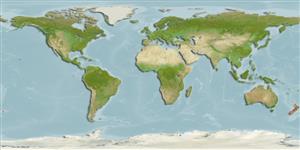Environment: milieu / climate zone / depth range / distribution range
Ökologie
seewasser; süßwasser; brackwasser demersal; katadrom (Ref. 51243). Subtropical; 34°S - 47°S
Southwest Pacific: endemic to New Zealand.
Length at first maturity / Size / Gewicht / Alter
Maturity: Lm ?, range 80 - ? cm
Max length : 185 cm TL Männchen/unbestimmt; (Ref. 44724); 156.0 cm TL (female); common length : 60.0 cm TL Männchen/unbestimmt; (Ref. 9258); common length :100 cm TL (female); max. veröff. Gewicht: 25.0 kg (Ref. 11115)
Commonly found in lakes and rivers (Ref. 9258). Inhabits stony rivers (Ref. 9072). Migrates to the sea to breed. Oviparous (Ref. 205). Marketed fresh, smoked and frozen; eaten fried and broiled (Ref. 9988). Reports of reaching up to 2 meters and 50 kilograms are rare and more common historically; in recent times, only a few exceed 120 cm TL (Ref. 82796).
Life cycle and mating behavior
Maturities | Fortpflanzung | Spawnings | Egg(s) | Fecundities | Larven
Armitage, R.O., D.A. Payne, G.J. Lockley, H.M. Currie, R.L. Colban, B.G. Lamb and L.J. Paul (eds.), 1994. Guide book to New Zealand commercial fish species. Revised edition. New Zealand Fishing Industry Board, Wellington, New Zealand, 216 p. (Ref. 9258)
IUCN Rote Liste Status (Ref. 130435)
Bedrohung für Menschen
Harmless
Nutzung durch Menschen
Fischereien: kommerziell; Aquakultur: experimental
Tools
Zusatzinformationen
Download XML
Internet Quellen
Estimates based on models
Preferred temperature (Ref.
123201): 10.6 - 18.3, mean 15.1 °C (based on 138 cells).
Phylogenetic diversity index (Ref.
82804): PD
50 = 0.5000 [Uniqueness, from 0.5 = low to 2.0 = high].
Bayesian length-weight: a=0.00093 (0.00076 - 0.00115), b=3.20 (3.15 - 3.25), in cm total length, based on LWR estimates for this species (Ref.
93245).
Trophic level (Ref.
69278): 4.5 ±0.5 se; based on diet studies.
Widerstandsfähigkeit (Ref.
120179): sehr niedrig, Verdopplung der Population dauert mehr als 14 Jahre. (Tmax=60; tm=10-48 years based on age-length relationship.).
Fishing Vulnerability (Ref.
59153): Very high vulnerability (90 of 100).
